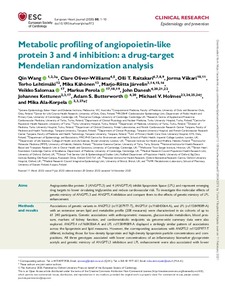Metabolic profiling of angiopoietin-like protein 3 and 4 inhibition: a drug-target Mendelian randomization analysis
Ala-Korpela Mika; Butterworth Adam S; Danesh John; Holmes Michael V; Järvelin Marjo-Riitta; Kettunen Johannes; Kähönen Mika; Lehtimäki Terho; Oliver-Williams Clare; Perola Markus; Raitakari Olli T; Salomaa Veikko; Viikari Jorma; Wang Qin
https://urn.fi/URN:NBN:fi-fe2021042827296
Tiivistelmä
Aims: Angiopoietin-like protein 3 (ANGPTL3) and 4 (ANGPTL4) inhibit lipoprotein lipase (LPL) and represent emerging drug targets to lower circulating triglycerides and reduce cardiovascular risk. To investigate the molecular effects of genetic mimicry of ANGPTL3 and ANGPTL4 inhibition and compare them to the effects of genetic mimicry of LPL enhancement.
Methods and results: Associations of genetic variants in ANGPTL3 (rs11207977-T), ANGPTL4 (rs116843064-A), and LPL (rs115849089-A) with an extensive serum lipid and metabolite profile (208 measures) were characterized in six cohorts of up to 61 240 participants. Genetic associations with anthropometric measures, glucose-insulin metabolism, blood pressure, markers of kidney function, and cardiometabolic endpoints via genome-wide summary data were also explored. ANGPTL4 rs116843064-A and LPL rs115849089-A displayed a strikingly similar pattern of associations across the lipoprotein and lipid measures. However, the corresponding associations with ANGPTL3 rs11207977-T differed, including those for low-density lipoprotein and high-density lipoprotein particle concentrations and compositions. All three genotypes associated with lower concentrations of an inflammatory biomarker glycoprotein acetyls and genetic mimicry of ANGPTL3 inhibition and LPL enhancement were also associated with lower C-reactive protein. Genetic mimicry of ANGPTL4 inhibition and LPL enhancement were associated with a lower waist-to-hip ratio, improved insulin-glucose metabolism, and lower risk of coronary heart disease and type 2 diabetes, whilst genetic mimicry of ANGPTL3 was associated with improved kidney function.
Conclusions: Genetic mimicry of ANGPTL4 inhibition and LPL enhancement have very similar systemic metabolic effects, whereas genetic mimicry of ANGPTL3 inhibition showed differing metabolic effects, suggesting potential involvement of pathways independent of LPL. Genetic mimicry of ANGPTL4 inhibition and LPL enhancement were associated with a lower risk of coronary heart disease and type 2 diabetes. These findings reinforce evidence that enhancing LPL activity (either directly or via upstream effects) through pharmacological approaches is likely to yield benefits to human health.
Kokoelmat
- Rinnakkaistallenteet [19206]
